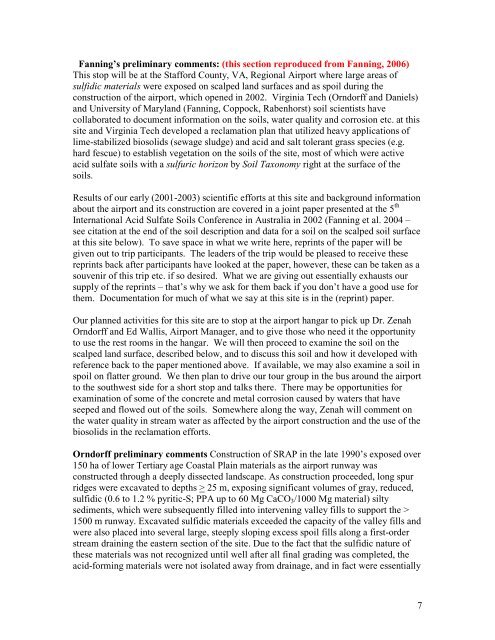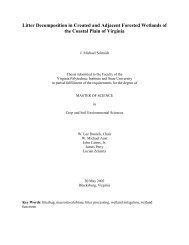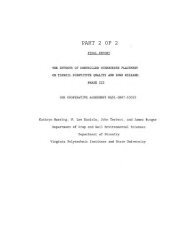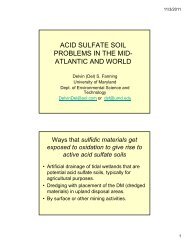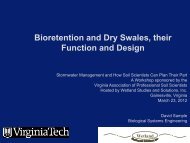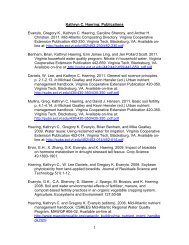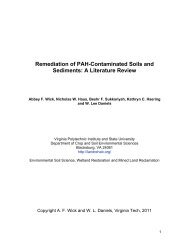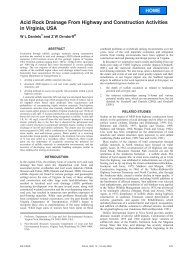ACID SULFATE SOILS - Sawgal.umd.edu - University of Maryland
ACID SULFATE SOILS - Sawgal.umd.edu - University of Maryland
ACID SULFATE SOILS - Sawgal.umd.edu - University of Maryland
Create successful ePaper yourself
Turn your PDF publications into a flip-book with our unique Google optimized e-Paper software.
Fanning’s preliminary comments: (this section reproduced from Fanning, 2006)<br />
This stop will be at the Stafford County, VA, Regional Airport where large areas <strong>of</strong><br />
sulfidic materials were exposed on scalped land surfaces and as spoil during the<br />
construction <strong>of</strong> the airport, which opened in 2002. Virginia Tech (Orndorff and Daniels)<br />
and <strong>University</strong> <strong>of</strong> <strong>Maryland</strong> (Fanning, Coppock, Rabenhorst) soil scientists have<br />
collaborated to document information on the soils, water quality and corrosion etc. at this<br />
site and Virginia Tech developed a reclamation plan that utilized heavy applications <strong>of</strong><br />
lime-stabilized biosolids (sewage sludge) and acid and salt tolerant grass species (e.g.<br />
hard fescue) to establish vegetation on the soils <strong>of</strong> the site, most <strong>of</strong> which were active<br />
acid sulfate soils with a sulfuric horizon by Soil Taxonomy right at the surface <strong>of</strong> the<br />
soils.<br />
Results <strong>of</strong> our early (2001-2003) scientific efforts at this site and background information<br />
about the airport and its construction are covered in a joint paper presented at the 5 th<br />
International Acid Sulfate Soils Conference in Australia in 2002 (Fanning et al. 2004 –<br />
see citation at the end <strong>of</strong> the soil description and data for a soil on the scalped soil surface<br />
at this site below). To save space in what we write here, reprints <strong>of</strong> the paper will be<br />
given out to trip participants. The leaders <strong>of</strong> the trip would be pleased to receive these<br />
reprints back after participants have looked at the paper, however, these can be taken as a<br />
souvenir <strong>of</strong> this trip etc. if so desired. What we are giving out essentially exhausts our<br />
supply <strong>of</strong> the reprints – that’s why we ask for them back if you don’t have a good use for<br />
them. Documentation for much <strong>of</strong> what we say at this site is in the (reprint) paper.<br />
Our planned activities for this site are to stop at the airport hangar to pick up Dr. Zenah<br />
Orndorff and Ed Wallis, Airport Manager, and to give those who need it the opportunity<br />
to use the rest rooms in the hangar. We will then proceed to examine the soil on the<br />
scalped land surface, described below, and to discuss this soil and how it developed with<br />
reference back to the paper mentioned above. If available, we may also examine a soil in<br />
spoil on flatter ground. We then plan to drive our tour group in the bus around the airport<br />
to the southwest side for a short stop and talks there. There may be opportunities for<br />
examination <strong>of</strong> some <strong>of</strong> the concrete and metal corrosion caused by waters that have<br />
seeped and flowed out <strong>of</strong> the soils. Somewhere along the way, Zenah will comment on<br />
the water quality in stream water as affected by the airport construction and the use <strong>of</strong> the<br />
biosolids in the reclamation efforts.<br />
Orndorff preliminary comments Construction <strong>of</strong> SRAP in the late 1990’s exposed over<br />
150 ha <strong>of</strong> lower Tertiary age Coastal Plain materials as the airport runway was<br />
constructed through a deeply dissected landscape. As construction proceeded, long spur<br />
ridges were excavated to depths > 25 m, exposing significant volumes <strong>of</strong> gray, r<strong>edu</strong>ced,<br />
sulfidic (0.6 to 1.2 % pyritic-S; PPA up to 60 Mg CaCO 3 /1000 Mg material) silty<br />
sediments, which were subsequently filled into intervening valley fills to support the ><br />
1500 m runway. Excavated sulfidic materials exceeded the capacity <strong>of</strong> the valley fills and<br />
were also placed into several large, steeply sloping excess spoil fills along a first-order<br />
stream draining the eastern section <strong>of</strong> the site. Due to the fact that the sulfidic nature <strong>of</strong><br />
these materials was not recognized until well after all final grading was completed, the<br />
acid-forming materials were not isolated away from drainage, and in fact were essentially<br />
7


